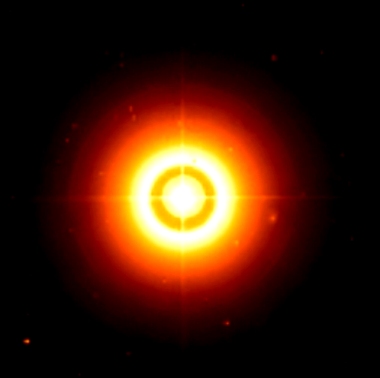
Tau Ceti is the most Sun-like of the 30 nearest stars to
the Sun. It lies in the constellation Cetus and is easily visible
without a telescope. Tau Ceti has been the target of many SETI (Search
for Extraterrestrial Intelligence) programs including the first,
Project Ozma, which also looked at Epsilon Eridani. It is also the
first star to be found to have a disk of dust and comets around it
similar in size and shape to the disk of comets and asteroids that
orbits the Sun. However, the similarity ends there because it appears
that Tau Ceti has more than ten times the number of comets and
asteroids that there are in our Solar System.
In Star Trek, the USS Enterprise, under the command of
Captain James T. Kirk, engaged and defeated a Romulan vessel near Tau
Ceti, using the Cochrane deceleration maneuver. (TOS: "Whom Gods
Destroy")
This system was the site of the Tau Ceti Accords signed
between the Vulcan High Command and the Andorian Empire. (ENT: "Shadows
of P'Jem")
Tau Ceti is notable in the mirror universe, as the
system in which the Terran Empire lost twelve ships in a battle against
alien rebels. Propaganda had spread that this was a major win for the
Terran Empire, when in fact it was a sign they were beginning to lose.
(ENT: "In a Mirror, Darkly").
Vice Admiral Janeway (the father of Captain Kathryn
Janeway of the USS Voyager) died on Tau Ceti Prime, drowned under an
ice cap. (VOY: "Coda")
In reality, Tau Ceti is a main sequence, yellow-orange
dwarf (G8 Vp) that may be as much as 10 billion years old. It has about
81 to 82 percent of Sol's mass, around 77 percent its diameter, but
only 59 percent of its luminosity (Saumon et al, 1996, page 17). The
star does not appear to be as enriched as Sol in elements heavier than
hydrogen ("metals") because it has only 22 to 74 percent of Sol's
abundance of iron.
It is not known if the star is accompanied by any
planets – its low metallicity makes it questionable whether the nebula
from which it condensed had sufficient heavy element content to allow
planet-sized objects to form). However, if any planets are present, as
hypothesized in the accompanying painting, they are likely to be
subjected to a much more intense bombardment than anything the Earth
has experienced, making the survival of any life problematic.
This star is located only about 11.9 light-years (ly)
away. It lies in the south central part of Constellation Cetus, the
Whale. While smaller and cooler than our own Sun, Sol, Tau Ceti is
somewhat more like a sister star than nearby Epsilon Eridani. In
Earth's night sky, it is clearly visible to the naked eye and easily
visible without a telescope.
In July 2004, astronomers announced that they had imaged
a relatively large and dense disk of cold dust around this star. Tau
Ceti has more than ten times the amount of cometary and asteroidal
material orbiting it than does our Sun. This was determined by
measuring the disc of cold dust orbiting the star produced by
collisions between such small bodies. Extending to around 55 AUs from
the star, this dust is believed to be produced by collisions between
larger comets and asteroids that break them down into smaller and
smaller pieces, and Tau Ceti's disk is similar in size and shape to the
disk of comets and asteroids that orbits the Sun, Sol. Given Tau Ceti's
estimated age of 10 billion years, the estimated mass of its dust disk
fits its expected decline with time compared to the disk mass of the
younger nearby star Epsilon Eridani, which may only be 500 million to
one billion years old. This result puts a damper on the possibility of
complex life in this system, as planets there would suffer from large
impact events roughly ten times more frequently than Earth. However, it
is possible that a large Jupiter-sized gas giant could deflect comets
and asteroids
Why the Tau Ceti System would have a more massive
cometary disk than the Solar System is not fully understood. One theory
is that Sol may have passed relatively close to another star at some
point in its history and that the close encounter stripped off most of
its comets and asteroids. Although no planets have been detected
orbiting Tau Ceti as yet, it is likely that any planet found to orbit
within the star's dust disk would experience relatively frequent
bombardment from asteroids and comets of the size that is believed to
have wiped out the dinosaurs and other types of multi-cellular life on
Earth. As a result, some astronomers have speculated that it is likely
that with so many large impacts, large and complex forms of Earth-type
multi-cellular life may not have had the opportunity to evolve and
persist on inner terrestrial planets orbiting this star. Others,
however, argue that a giant planet in the system could gravitationally
deflect comets and asteroids away from inner planets that may support
life in the liquid water zone, in the same way that Jupiter protects
Earth in the Solar System.
|
